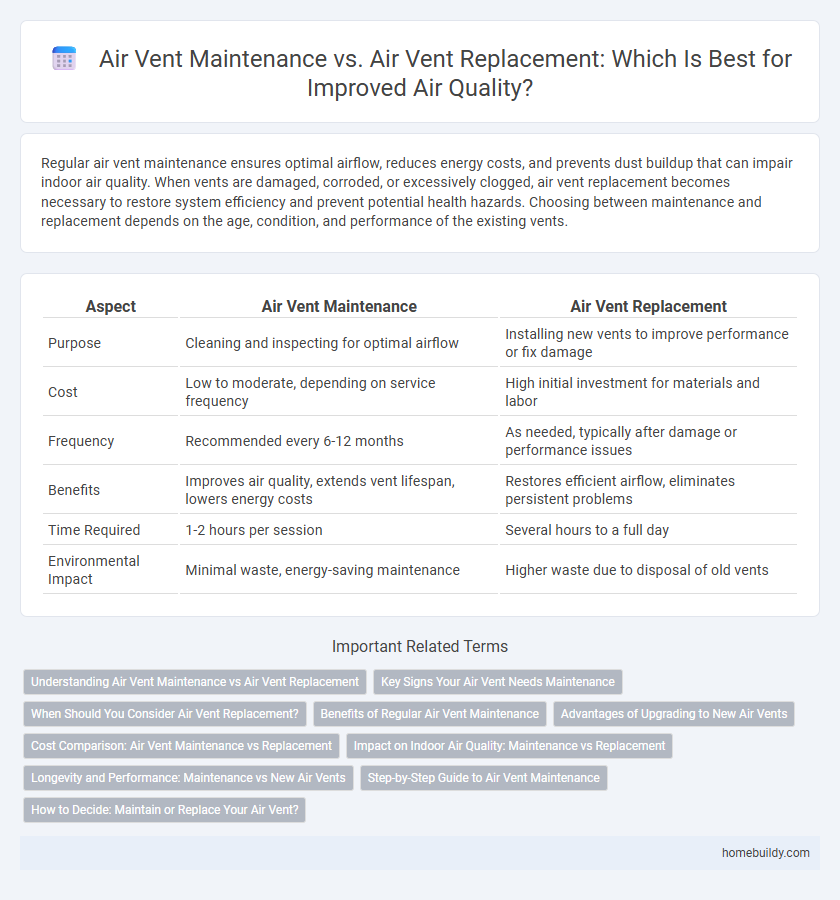Regular air vent maintenance ensures optimal airflow, reduces energy costs, and prevents dust buildup that can impair indoor air quality. When vents are damaged, corroded, or excessively clogged, air vent replacement becomes necessary to restore system efficiency and prevent potential health hazards. Choosing between maintenance and replacement depends on the age, condition, and performance of the existing vents.
Table of Comparison
| Aspect | Air Vent Maintenance | Air Vent Replacement |
|---|---|---|
| Purpose | Cleaning and inspecting for optimal airflow | Installing new vents to improve performance or fix damage |
| Cost | Low to moderate, depending on service frequency | High initial investment for materials and labor |
| Frequency | Recommended every 6-12 months | As needed, typically after damage or performance issues |
| Benefits | Improves air quality, extends vent lifespan, lowers energy costs | Restores efficient airflow, eliminates persistent problems |
| Time Required | 1-2 hours per session | Several hours to a full day |
| Environmental Impact | Minimal waste, energy-saving maintenance | Higher waste due to disposal of old vents |
Understanding Air Vent Maintenance vs Air Vent Replacement
Regular air vent maintenance involves cleaning, inspecting for blockages or damage, and ensuring proper airflow to enhance HVAC efficiency and indoor air quality. Air vent replacement becomes necessary when vents are corroded, cracked, or no longer fit correctly, which can lead to energy loss and compromised system performance. Understanding the balance between routine maintenance and timely replacement helps prevent costly repairs and maintains optimal ventilation.
Key Signs Your Air Vent Needs Maintenance
Key signs your air vent needs maintenance include reduced airflow, unusual odors, and visible dust accumulation on vents and registers. Increased energy bills can indicate clogged or dirty vents that hinder HVAC efficiency. Regular inspection for mold growth or strange noises helps prevent costly air vent replacement by addressing issues early.
When Should You Consider Air Vent Replacement?
Air vent replacement should be considered when vents show signs of severe damage, such as cracks, warping, or rust, which cannot be effectively repaired through maintenance. Persistent issues like poor airflow, unusual noises, or mold growth indicate that replacement is necessary to ensure optimal indoor air quality and system efficiency. Replacing air vents every 10 to 15 years is recommended to maintain HVAC performance and prevent costly energy losses.
Benefits of Regular Air Vent Maintenance
Regular air vent maintenance improves indoor air quality by preventing dust, mold, and allergens from accumulating, ensuring a healthier environment. It enhances HVAC system efficiency, reducing energy consumption and lowering utility bills through optimal airflow. Timely maintenance extends the lifespan of air vents, avoiding costly replacements and preserving system performance.
Advantages of Upgrading to New Air Vents
Upgrading to new air vents enhances indoor air quality by incorporating advanced filtration technology that traps more pollutants and allergens efficiently. Modern air vents improve airflow distribution, leading to better HVAC system performance and increased energy savings. New air vents also reduce noise levels and require less frequent maintenance, offering long-term durability and cost-effectiveness compared to older units.
Cost Comparison: Air Vent Maintenance vs Replacement
Air vent maintenance typically costs between $50 and $150 annually, focusing on cleaning and minor repairs to ensure optimal airflow and prevent buildup. Replacement expenses can range from $300 to $1,200 depending on vent size, material, and labor, often warranted when vents are severely damaged or outdated. Evaluating cost-effectiveness involves weighing frequent maintenance fees against the one-time investment of replacement for long-term HVAC efficiency.
Impact on Indoor Air Quality: Maintenance vs Replacement
Regular air vent maintenance, including cleaning and filter replacement, significantly improves indoor air quality by reducing dust, allergens, and mold buildup within the ventilation system. Air vent replacement is necessary when vents are damaged, corroded, or outdated, preventing contaminants from circulating and ensuring optimal airflow and air filtration efficiency. Neglecting maintenance or delaying replacement can lead to poor ventilation, increased pollutant levels, and potential respiratory health issues.
Longevity and Performance: Maintenance vs New Air Vents
Regular air vent maintenance, including cleaning and inspection, significantly enhances system longevity and ensures optimal airflow performance by preventing blockages and reducing wear. While maintenance extends the lifespan of existing vents, replacing old or damaged air vents with new, high-quality models can improve energy efficiency and indoor air quality more effectively. Choosing between maintenance and replacement depends on the vent's condition, with proactive maintenance preserving investment and timely replacement delivering superior long-term performance.
Step-by-Step Guide to Air Vent Maintenance
Regular air vent maintenance extends system efficiency by preventing dust buildup and ensuring consistent airflow. Step-by-step air vent cleaning involves turning off the HVAC system, removing vent covers, using a vacuum with a brush attachment to clear debris, and wiping down with a damp cloth. Replacement becomes necessary when vents show signs of physical damage, corrosion, or persistent mold growth, conditions that routine maintenance cannot resolve.
How to Decide: Maintain or Replace Your Air Vent?
Evaluating whether to maintain or replace your air vent depends on factors like the age of the vent, frequency of airflow issues, and presence of mold or damage. Routine cleaning and minor repairs extend the life of air vents, but persistent clogging, rust, or structural deterioration signal replacement is necessary. Consulting HVAC professionals can provide a thorough inspection to ensure optimal indoor air quality and system efficiency.
Air vent maintenance vs Air vent replacement Infographic

 homebuildy.com
homebuildy.com